Vali Castle in Ilam
Today I want you to discover a different style of the art of creation, …
Destination
Having forest resorts and ancient monuments, Ilam is known as the “bride of Zagros Nature” and is considered as one of the most prominent and eye-appealing cities of western Iran. Ilam Province is also recognized as the cleanest and the most authentic province in Iran.
There are various waterfalls in Ilam, one of the well-known ones is Gechan Waterfall which you must visit. There are other natural sites you will find peaceful like Ilam Dam Lake, Sarab Park, Razyane Strait, Conatarike Cave, and Cheshmeye Ghire Dehloran (Dehloran Spring). Note that there are various mills in different parts of this province that are worth a visit. Falahati Palace and Vali Castle are historical sites of Ilam.

Gavmishan Bridge, Razyaneh Canyon, Ancient Bahram Choubin Castle, and Kafari Badreh Canyon are stonishing natural landscapes in Darreh Shahr in Ilam Province. Ilam has magnificent handmade Kelims with colorful patterns that you will definitely find them mesmerizing. You can also buy Giveh which is soft handmade shoes. Do not forget to try the many tasty sweets in this province. If you are looking for more adventure, Ilam is a perfect spot for you camping along with its different natural sites. There are also so many hiking and trekking routes which you will find serene and untouched.
It is a mountainous province with semi-humid weather; since it has untouched and various natural sites, it is recommended to choose the best time of the year for your travel to Ilam. It has harsh weather in December and July. We suggest you have your adventure in this authentic land during autumn or spring.
30-Day Iran Visa Delivered in 3 Days
The safe solution
The freedom to explore Iran
The fastest, most reliable & efficient
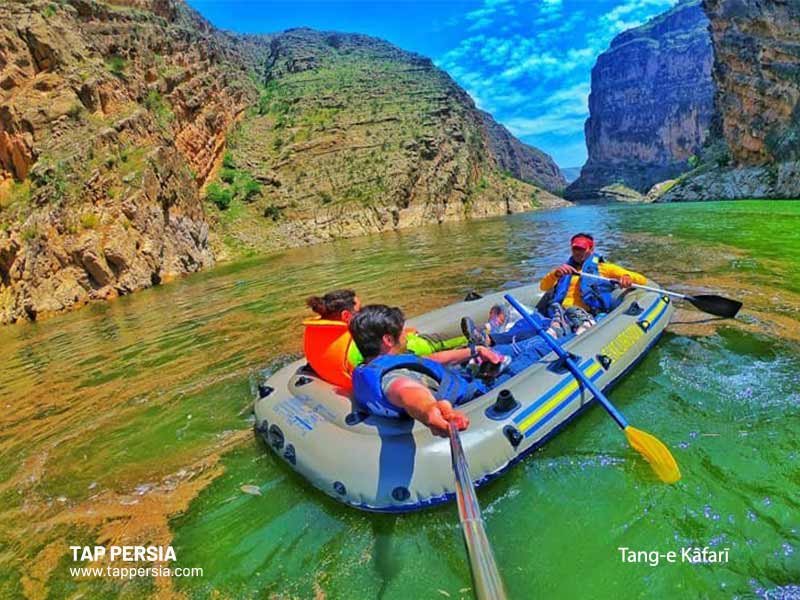
Kafari Canyon is located in the beautiful and spectacular province of Ilam. They also call it the bride of Zagros. This province has many amazing and spectacular canyons and valleys. They are the best place to set up exciting tours and have an adventurous trip in the heart of the pristine and green nature of this region of the country.
The river flowing through the Kafari canyon gives you the chance to go boating. Crossing the canyon and drowning in the spectacular beauties of nature is awaiting you there.
Siah Gav Twin Lakes is a natural aquarium located in mountainous and relatively high areas of Sarabbagh in Abdanan County, in Ilam province. This very rare natural phenomenon consists of two lakes that are connected by a canal. The canal is about 8 meters wide and 70 meters long and 4 meters deep. Surprisingly, this canal has a water discharge of about 240 cubic meters per hour. But The maximum diameter of the lakes is 80 meters. And the maximum depth reaches 30 meters at the deepest point.
The interesting thing about these lakes is that their water is very clear and transparent. So that you can see through up to 30 meters into the water. The water of the lakes is supplied through underground sources. These lakes are thousands of years old. And unfortunately, they are getting smaller day by day due to erosion.
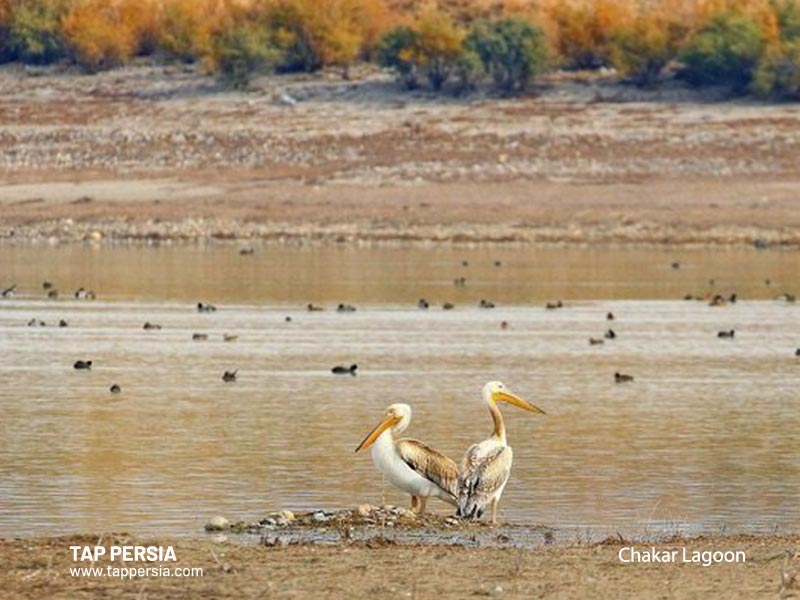
In the west of Ilam city, in Bowli region, you can find Chakar Lagoon. This lagoon has an area of about 3 hectares. And it is about 2.5 meters deep. This wetland is located in the tropics, but its water is permanent. Additionally, its depth depends on the amount of rainfall during the year. Its water source is rainfall and several boiling springs. The average temperature there is about 24 degrees Celsius.
The surrounding reeds along with the beautiful pristine nature around it are really pleasant and have made it one of the most spectacular places in Ilam. This wetland is also home to birds such as Coots, Grebes, Gray Heron, Gadwall, and Mallard.
Arghavan Valley is a big valley in one of the most beautiful protected areas in Ilam. Obviously, they call it Arghavan (Judas-tree) Valley because of the huge number of Judas trees throughout the region. Since Judas shrubs usually bloom in May, this month of the year the whole valley is full of pink and purple blossoms. Add this beauty to the various colors of other trees and plants. This area looks like a dream at this time of the year.
The Valley is about 170 hectares. And except for Judastrees, it is home to rare and endangered species of trees. Remember that the flowers of this plant last only about two weeks, so do some research before traveling. The valley has a river and several springs, but still, take drinking water with you.
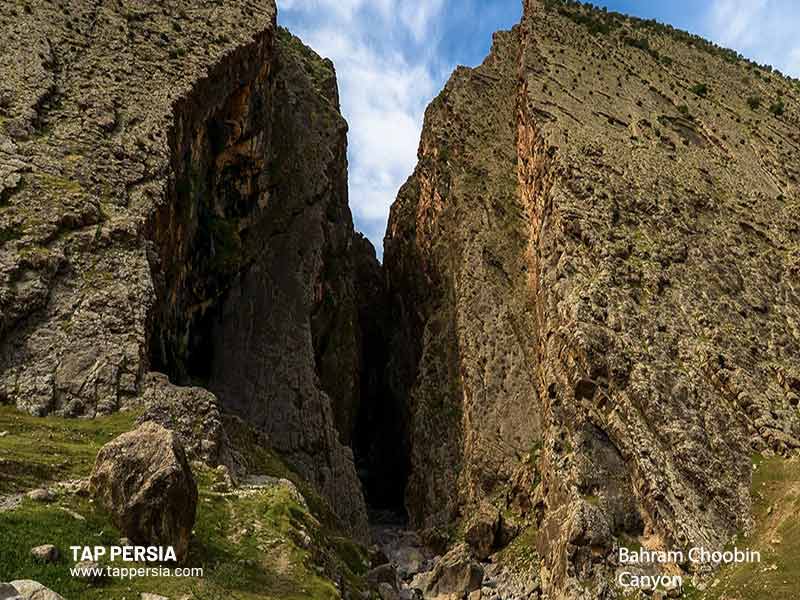
You can find Bahram Choobin Canyon around the city of Darreh Shahr. Darreh Shahr is a city at the foot of Kabir Kuh mountain and on the banks of the Seimare River. Inside the canyon, as well as the area behind it, is a very suitable and pristine environment for many different animals and birds.
According to ancient legends, Bahram, a Sassanid general, came to this place in ancient times to hunt. Also, this gorge is located in one of the greenest and most pleasant areas of Ilam province. That’s why Bahram considered this region as an attractive destination for fun and entertainment with the exciting taste of hunting.
Sheshdar Forest Park(Iran tourism places) is one of the most important and popular resorts in Ilam. This beauty is 5 km away from the city. Due to the beauty of its nature in spring and autumn, it is one of the most visited tourist areas. Of course, its proximity to Manjal, which is another most visited resort in the area, is another reason. Qal‘eh Qīrān mountain, the symbol of Ilam, is located in this region of the country, as well.
Chagha Sabz Forest Park is one of the most pleasant tourist attractions in Ilam. This forest park has an area of about four thousand hectares. In this dense forest, which is covered with oak, pistachio, hawthorn, and various plant species, you can also find trees such as pine, cypress, acacia, prunus scoparia, and walnut. This forest park also has rare and beautiful birds like Bitterns.
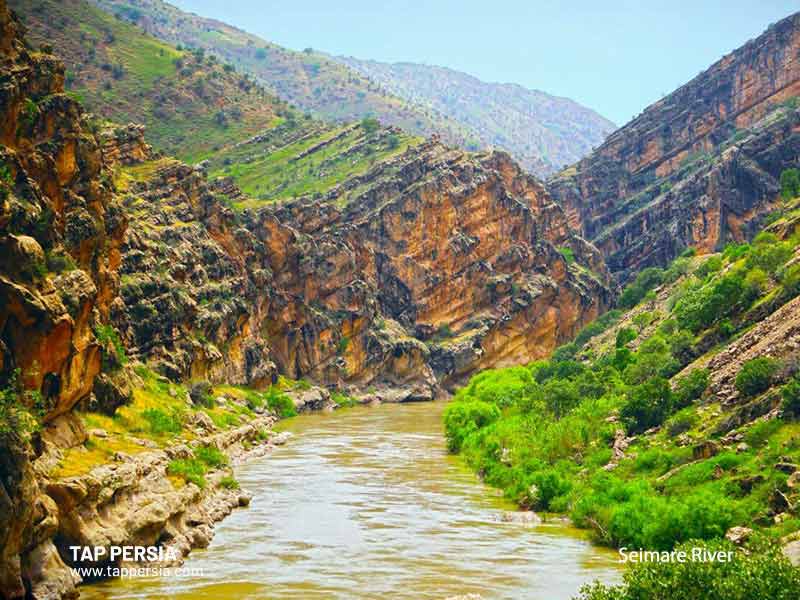
Seymareh or Seimare River is one of the rivers in the western lands of Iran and one of the sights of Darreh Shahr. This river is one of the important tributaries of the Karkheh river which originates from the snowy heights of northwestern Iran.
Dehloran hot sulfur springs are among the sights of Ilam. They are located 3 km away from Dehloran city in Ilam province at the foot of Siah Kuh mountain and close to Bat Cave.
This hot spring with a temperature of about 50 degrees Celsius has sanitary hot springs and mud therapy pools, which is of special therapeutic importance. The water of Dehloran hot springs shows itself in seven colors during the day due to the reflection of sunlight. The healing properties of this spring are very effective for rheumatism, allergies, heartburn, wounds, as well as bone fractures and contusions.
Abtaf Waterfall is located on the way from Maymeh to Zarrin Abad, the Dehloran city. They say this waterfall is one of the most beautiful waterfalls in Ilam province and Dehloran sights. Above all, it is one of the largest waterfalls in the country. Also, the space around Abtaf waterfall is one of the most popular promenades in the province for the locals.
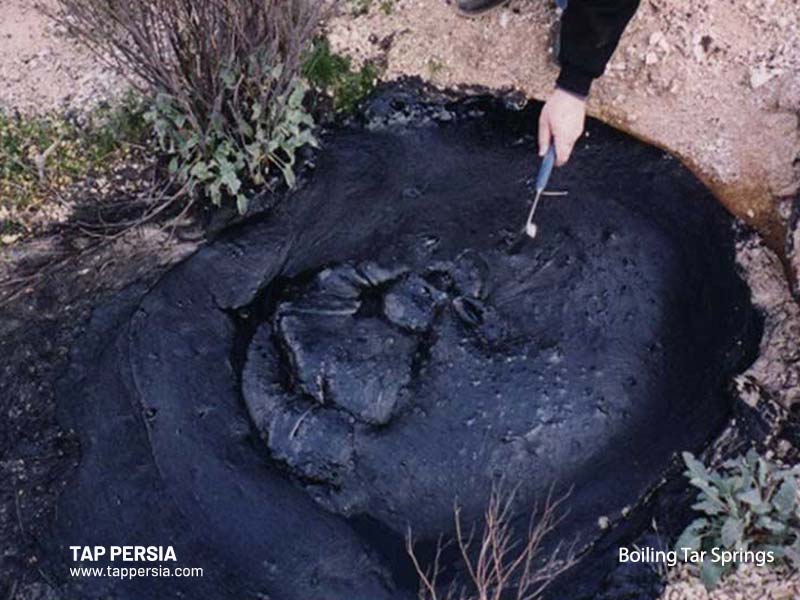 In Boiling Tar Springs or Ghir-Joushan Springs, natural tar seeps out of the ground like a boiling spring. Interestingly, sometimes it mixes with the water spring next to it and flows from top to bottom. The activity of these springs starts in spring and reaches its maximum in summer due to high heat. Consequently, lubricated tar mixes with soil and sand in their path to form natural asphalt.
In Boiling Tar Springs or Ghir-Joushan Springs, natural tar seeps out of the ground like a boiling spring. Interestingly, sometimes it mixes with the water spring next to it and flows from top to bottom. The activity of these springs starts in spring and reaches its maximum in summer due to high heat. Consequently, lubricated tar mixes with soil and sand in their path to form natural asphalt.
The Koulak no-hunting zone covers an area of 76,000 hectares, of which 50,000 hectares have been upgraded to a protected area. Koulak Protected Area is one of the sights of Mehran city. This land is an area that has many habitats with a large variety of wildlife.
On the eastern side of Sarab Ivan village on the top of Manesht mountain, there is the Telesm Ivan Cave. This cave is the habitat of mountain predators. In this cave, everything is ready to surprise and terrify you. From the entrance to the end of the cave is about 300 meters. The first 100 meters of which is open space and the rest is covered with a roof where you can see stalagmites.
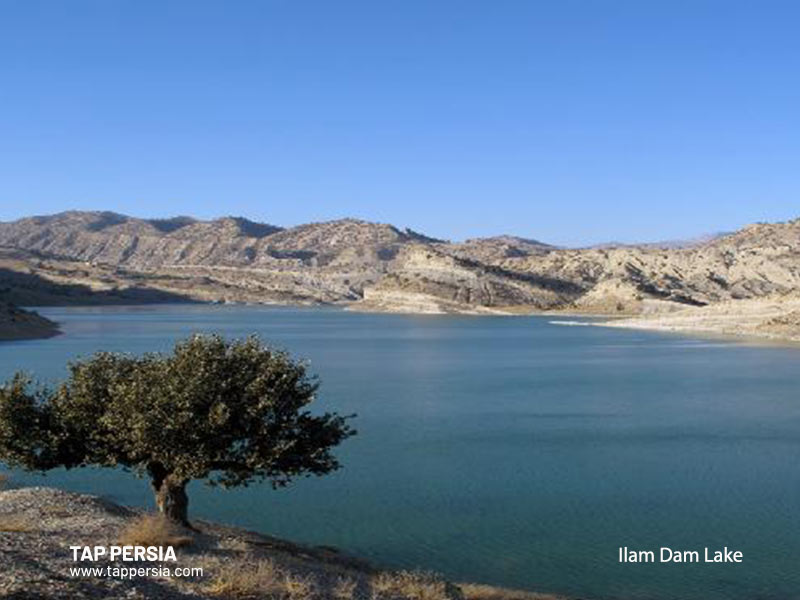
They put Ilam Dam into operation in recent years with its main purpose is to supply drinking water to the city. Anyway, now, in all seasons, especially spring and summer, people go for a picnic there and enjoy the beauty. Despite the lack of facilities and welfare services along the dam, tourists still consider Ilam Dam Lake as one of their important recreational destinations.
The Strait of Razianeh is one of the geological phenomena in Ilam province in western Iran. And since the Ilam-Darreh Shahr road passes right next to it, many tourists stop here to see the pristine and beautiful nature of the strait to enjoy the unique natural features and mountainous scenery. The limestones of this national natural monument of the Strait of Razianeh have been transformed into stunning shapes due to water erosion.
Qiran Castle (Qaleh Qīrān) is one of the historical castles of Iran and the sights of Ilam. They built this castle on the top of Qiran Mountain, which overlooks a very beautiful forest area, Sheshdar. The castle building and the mountain have created a beautiful landscape for the city. Qiran Castle is a symbol of the city. This castle belongs to the Parthian period to the post-Islamic historical periods. Access to this castle is not easy due to its location at the top of the mountain. But from this castle, you will see a beautiful view of the city of Ilam and the surrounding forests.
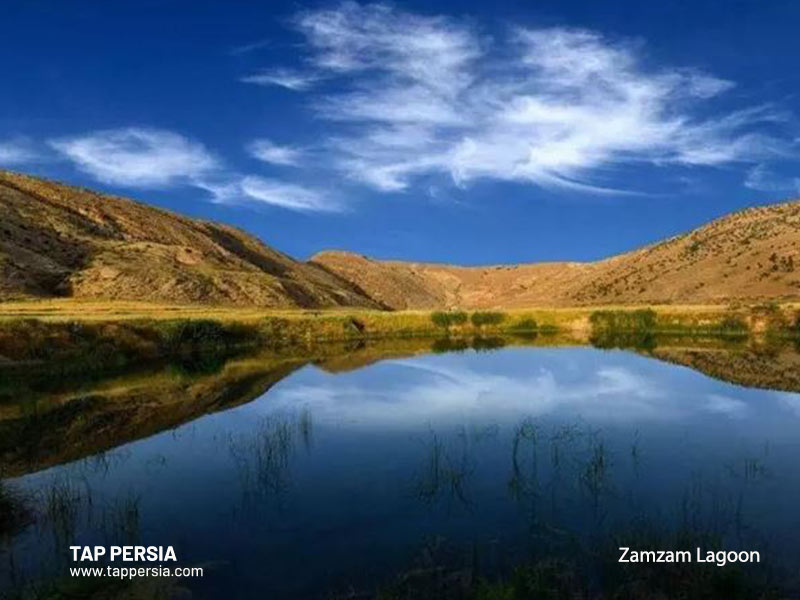 Zamzam Lagoon is one of the tourist attractions of Ilam, 74 km east of the city. Its area is about 1 hectare and its height above sea level is about 675 meters. The surrounding springs supply its water and it has permanent water. The surrounding vegetation has created a beautiful landscape and provided a very suitable habitat for wildlife.
Zamzam Lagoon is one of the tourist attractions of Ilam, 74 km east of the city. Its area is about 1 hectare and its height above sea level is about 675 meters. The surrounding springs supply its water and it has permanent water. The surrounding vegetation has created a beautiful landscape and provided a very suitable habitat for wildlife.
Cham Aw Waterfall at the foot of Bar Aseman mountain and along Cham Aw river at a distance of 18 km from the Ilam-Saleh Abad route, there is Cham Aava Waterfall. The water of this waterfall flows into the Gadar River after a short distance. Following the Cham Aw route and after passing through the village, there is a seasonal waterfall that creates an interesting view in the rainy seasons of the year. This three-step waterfall dries up over the summer.
Barreh Zard Cave with huge dimensions is one of the sights of Ilam in the heights of Mount Sivan. In the cave, you can see stones and columns, plus very beautiful stalactite and stalagmite sculptures. The height of some of the halls inside the cave reaches 12 meters. At a depth of 350 meters, there is a pool in the cave and the air inside is very cold. Despite the adequate amount of oxygen, no living creatures live in this cave due to the extreme cold.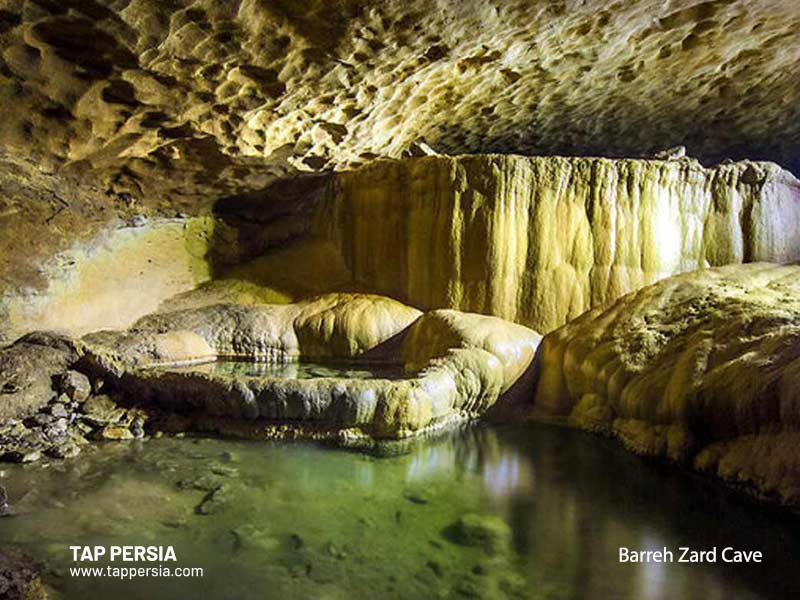
Tulav or Chamangir Mountain is one of the suitable and pristine destinations for mountaineering and nature tourism in Ilam. This mountain is located in Shirvan, 22 km southeast of Ilam. The height of the mountain is 2578 meters.
20 km after Ilam on the Chovar road, there is a promenade with beautiful and dense trees, Tajrian. This place is popular for its pleasant climate and beautiful nature.
Near Tajrian, there is another pleasant climate area known as “Tang-e Behesht”. Tang-e Behesht is also welcomed by tourists and travelers. And for the same reason, it hosts tourists most of the year.
Posht Ghale, also known as Abdanan Fortress, is located on a high hill at a distance of five kilometers in the southern part of Abdanan city. Doiraj River flows at the foot of this fortress. The materials used in the construction of this building include stone and plaster. The remains indicate the presence of watchtowers, fortifications, royal rooms, residential rooms, stairs, etc. The elliptical rampart, which reaches a height of three meters, surrounds the castle grounds.
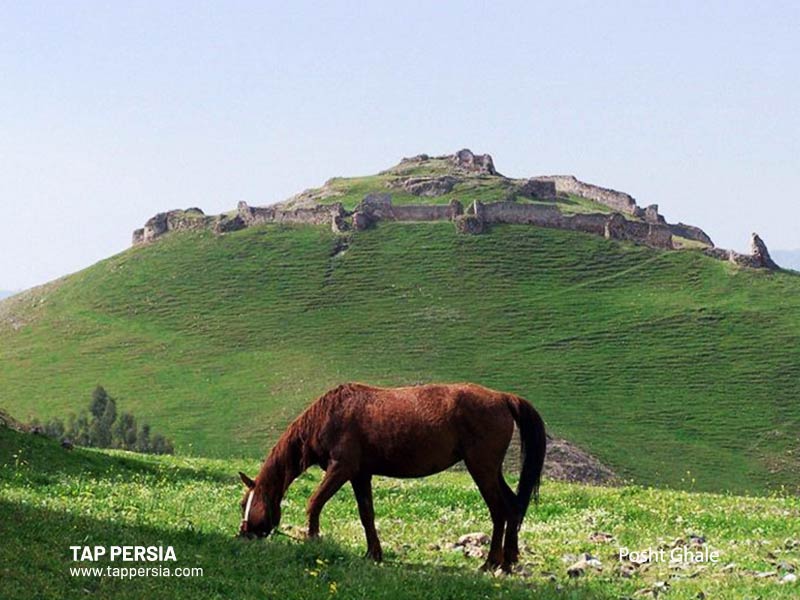 Moreover, the outer and main walls of the castle are almost intact. Dating back to the Sassanid period and post-Islamic historical periods, this work has been on Iran’s National Heritage List since March 8, 2003.
Moreover, the outer and main walls of the castle are almost intact. Dating back to the Sassanid period and post-Islamic historical periods, this work has been on Iran’s National Heritage List since March 8, 2003.
You can find Hezarani Castle along the Abdanan-Mormori road. It is shining on a natural hill at the beginning of Hezarani village in the northern part of the road. This hill is about 10 meters high. You can see stone and gypsum materials in the structure of the building. The construction is in the form of long rectangular corridors. But unfortunately, they are completely destroyed and buried under tons of soil.
This castle dates back to the Sassanid period and the early centuries of the post-Islamic historical period. Hezarani Castle has been on Iran’s Natural Heritage List since February 17, 2009.
You can find Julian Fortress in the northeastern part of the ancient city of Julian. It’s in Cham Kaboud village, 15 km from Abdanan city. On the slopes of Kabirkuh Mountain, Julian, nicknamed “Jillio” by the locals, is standing for more than 1500 years. On a natural hill overlooking this ancient city, there are traces of this old castle.
The materials of the building are stone and plaster. The stones are mostly from local rubble. Additionally, the wall of this fort does not have a special order.
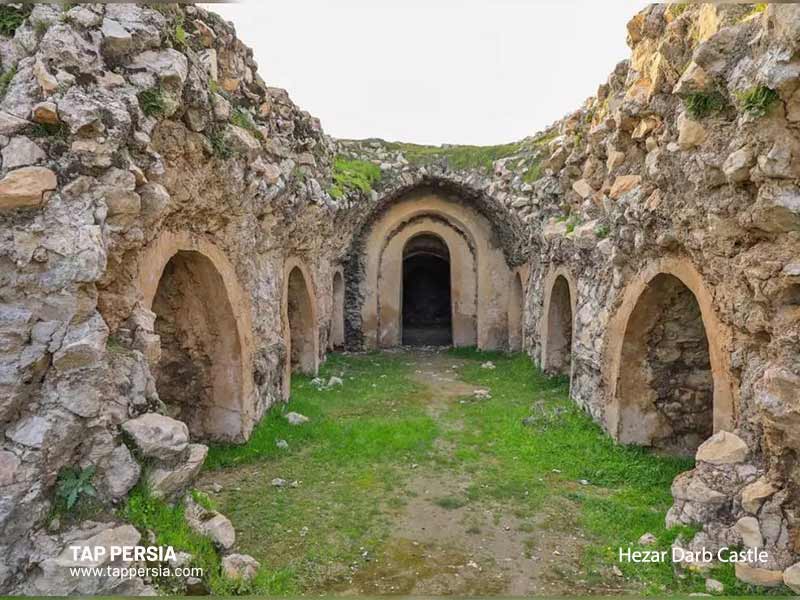
This castle is undoubtedly one of the most spectacular and amazing architectural works in the history of Iran. And for sure, it is one of the sights of Abdanan, which has a special architecture and beautiful crescent arches. This masterpiece dates back to the Sassanid period. Hezar Darb Castle has been on Iran’s National Heritage List since July 13, 2000.
An examination of the castle’s architecture shows that the Thousand Door Castle was most likely a military barrack. The main plan of the castle is rectangular. The materials in the construction of this rectangular castle include cut stones and rubble stones plus mortar.
Chenar Cemetery is another historical place and sight in Ilam. This ancient cemetery is located in the Chenar Bashi area. It dates back to a thousand years BC. They discovered a number of graves in this area in which the dead were buried inside small and large barrels along with their tools and objects.
The general shape of this Assyrian inscription is rectangular and it measures 90 by 135 cm. In the middle of Gulgul Malekshahi Inscription, there is the half-face and full-height figure of the king of Assyria. He has a conical hat and a long robe on his body down to his feet. He is carrying a sword as a symbol of power. Behind this person, there is the crescent moon, which may be a symbol of the celestial gods and goddesses.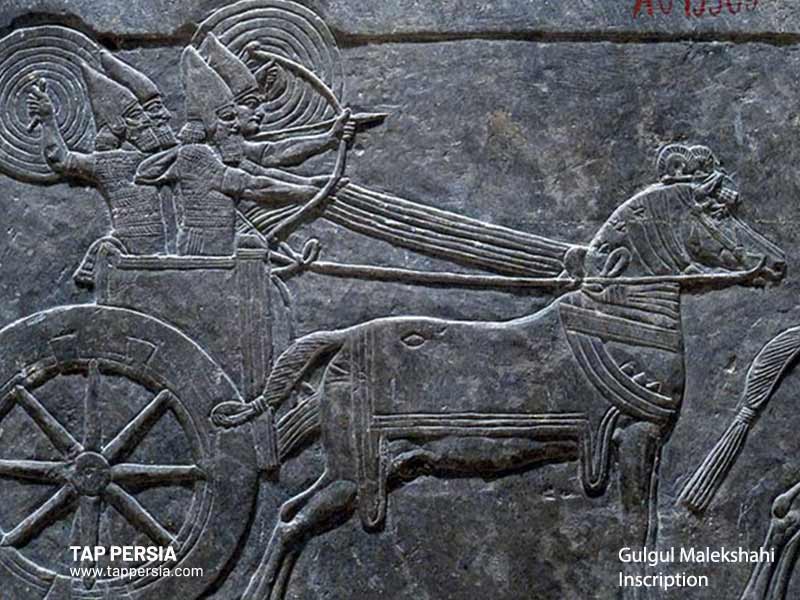
They say these gods rose up in support of the king of Assyria and helped him win the war and conquer the realm of the Cassians (Ilam and Lorestan). This Assyrian inscription was translated in 1973 by Mr. Vandenberg. The subject of the inscription tells of the conquest of Ilam and the extinction of this civilization by Assyria.
On the heights of Ilam city, there is a castle plus its fortifications known as Ismail Khan Castle. The area of the castle is mountainous and rocky which makes it difficult to cross. In the southeastern part, however, there is the communication route of the castle, which is more suitable.
They used mountain stones and gypsum mortar to build the castle.
Armu Cemetery is one of the most unique cemeteries of the late Islamic century. It is one of the sights of Ilam and is located in the eastern part of Darreh Shahr and on the way from Darreh Shahr to Poldakhtar city.
Some tombs have inscriptions with specific themes which belong to a century ago. These tombstones show one of the richest treasures of faith and livelihood and in general the indigenous culture of the region. We are talking about a culture that is not mentioned in any of the history books. Furthermore, easily you can see the beauty and simplicity of the local people’s lives by what the tombstones have to say.
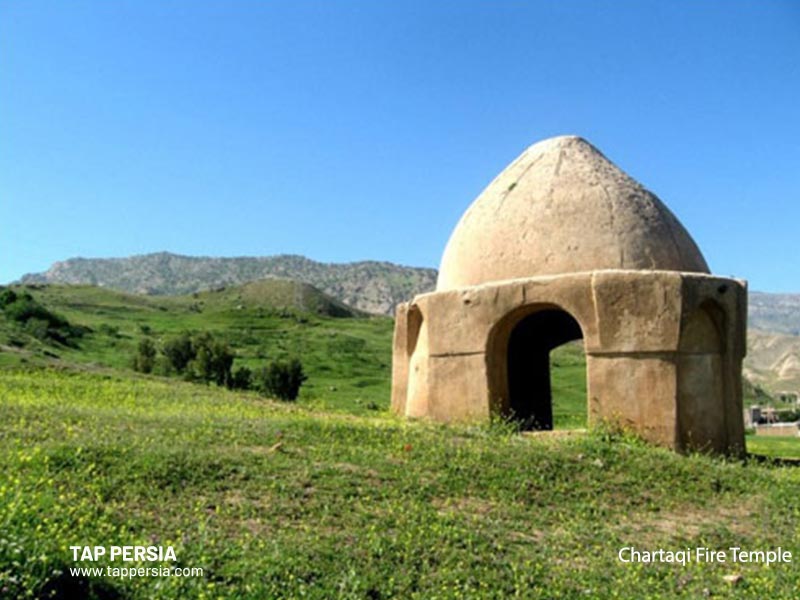
Se-Kasan Castle, also known as Se-Kasun Castle, is located southwest of Darreh Shahr on the rocky heights between Kabirkuh and Dareh Shahr plains. This castle is one of the largest and most extensive castles of the Sassanid-Islamic period in the region. Moreover, it is one of the tourist attractions of Darreh Shahr. This castle had been very difficult to access. And they used rubble and plaster to build it. The walls are constructed on rocks for more security and harder access. The castle also had a reservoir carved into the rocks.
Chartaq, chahartaq, chartaqi, or chahartaqi, literally means “having four arches”. This building has four barrel vaults and a dome. Chartaqi Fire Temple of Darreh Shahr is one of the historical sites of Ilam province. This work continues to its life on a hill in the form of a four-arched building, which the locals call Taq (the arch). Dating back to the Sassanid period, this fire temple was built of rubble and plaster. And its name appears in the list of national monuments of Iran and the sights of Darreh Shahr.
The area of this ancient city is over 200 hectares. This city is known by several names such as Madakto, Mehrjankadeh, and so on. In the ruins of this city, the common urban planning works of the Sassanid period are obvious. Some believe that Khosrow Parviz, the Sassanid king, built Seymareh (Madakto). Alexander the Great passed through this city when he left Susa. According to the estimations, this ancient city had over 5,000 houses at the time of its development.
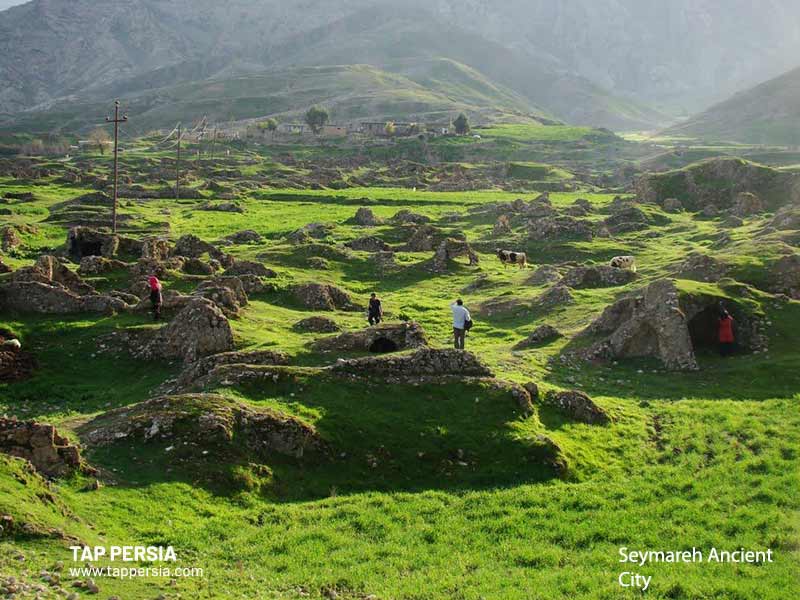 Madakto is a city 1400 years old. In this historic city, there were watchtowers, streets, drainage systems, and sewage disposal, which were unfortunately destroyed in an earthquake. But the remains of this city are still there.
Madakto is a city 1400 years old. In this historic city, there were watchtowers, streets, drainage systems, and sewage disposal, which were unfortunately destroyed in an earthquake. But the remains of this city are still there.
Pour Ashraf Castle, located in the village of “Sheikh Makan”, is one of the sights of Darreh Shahr. This castle is also known by other names such as “Sheikh Makan Castle”, “Mir Mohammad Khan Ashraf Al-Ashayer Castle” and “Mir Mohammad Khan Pour Ashraf Castle”. This fort is located about 6 km southeast of Darreh Shahr city in Ilam province, on the road from Darreh Shahr to Pol Dokhtar city. They built this fort in 1917 by the order of “Mir Seyyed Mohammad Khanpour Ashraf”, the ruler of the region during the Qajar period.
Ali Kosh Hill belongs to the eighth millennium BC. This hill, which is one of the tourist attractions of Dehloran, was explored by Frank Hull and his entourage between 1961 and 1963. Therefore, the results of this excavation have been presented in various books and articles. This area is near the Meymeh river in Ilam province.
Nomadism and agriculture, one-room mud houses, objects that indicate economic relations with the distant, the use of pottery, burial of the dead with personal belongings are some of the achievements of this ancient area.
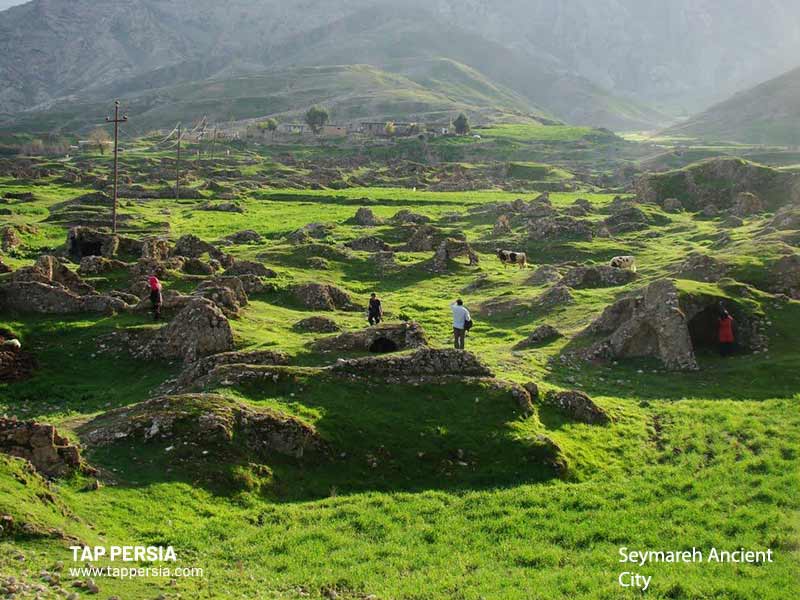
The Moshakan Fire Temple is one of the historical monuments of Ilam province and is located three kilometers away from Sarableh city. This fire temple dates back to the Sassanid period. Made of mortar and stone, this fire temple was largely destroyed by various accidents over time. The name of this historical attraction has been registered in the list of the national heritage of Iran.
The Gavmishan Bridge, which is one of the sights of Darreh Shahr, belongs to the Sassanid period. 30 km away from Darreh Shahr and on the border between Lorestan and Ilam provinces, on the Seymareh river, you can find this ancient bridge.
Mir Gholam Hashemi Castle, also known as Mir Gholam Hashemi Fortress and Sikan Castle, belongs to the early Pahlavi period. You can find his historical monument, in Hashem Abad village, close to Darreh Shahr city. It is now on Iran’s National Heritage List.
Konjan Cham Castle is one of the sights of Ilam, 15 km north of Mehran city in the Amirabad region in the middle of a valley with the same name. This fort is on the way to Karbala. The history of Konjan Cham Castle dates back to the late Qajar period. They built this fort in 1908 by the order of Gholam Reza Khan Abu Qadara, the last governor of Ilam.
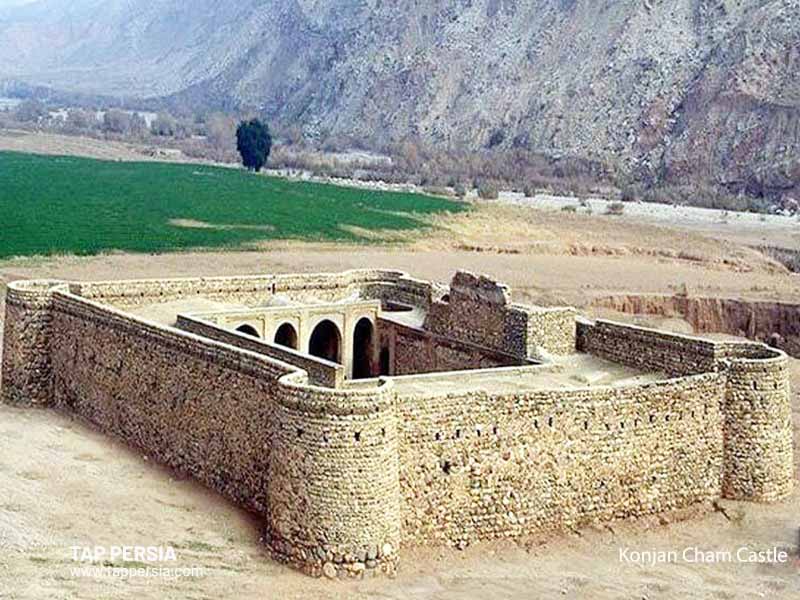 In fact, they built the fort to house the governor’s family in the winter. This place was where he set up his government headquarters and used it to collect tolls and taxes.
In fact, they built the fort to house the governor’s family in the winter. This place was where he set up his government headquarters and used it to collect tolls and taxes.
Konjan Cham Dam is one of the tourist attractions of Mehran city. This dam is an earthen dam with a clay core that is 79 meters high and the riverbed is 68 meters.
Vali Castle (Qaleh Vali)is one of the most important historical monuments and places of interest in Ilam. You can find it in the northern part of Pasdaran Street. This building was actually the residence of the governor in summer. They built it on a hill and its height is around 3.5 to 4 meters. There is an inscription in the building that mentions the history of this castle.
In 2006, they turned Qaleh Vali into the Ilam Anthropology Museum. This place, now, consists of different sections and is one of the richest specialized anthropological museums. This castle, as one of the most valuable historical monuments of Ilam, is a relic of the Qajar period. It is on Iran’s National Heritage List, also.
Siahgel Fire Temple belongs to the Sassanid period. You can find this fire temple 15 km southwest of Sartang village and along the roaring Kangir river. This building is one of the sights of Ilam and is one of the least damaged fire temples of the pre-Islamic era in this province. The building has four arches and a dome.
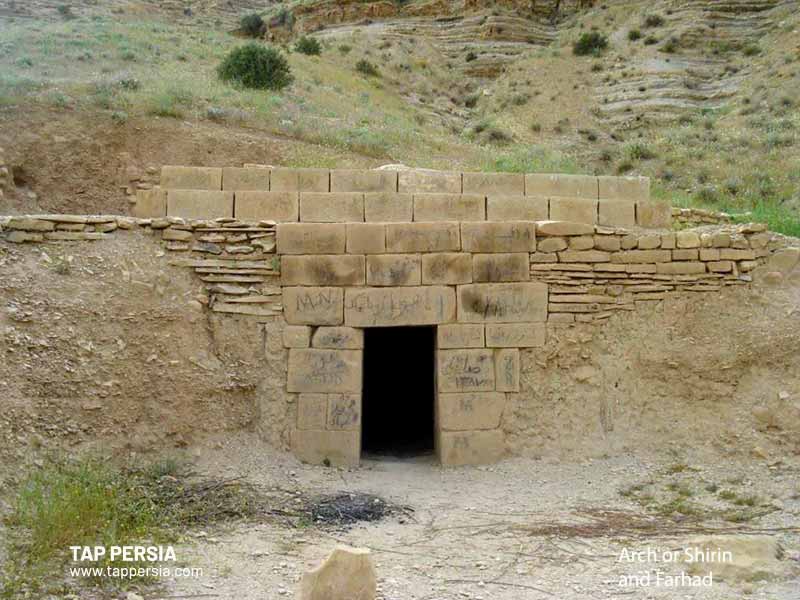
The Arch of Shirin and Farhad is one of the tourist attractions of Ilam with a love story behind it. According to the locals, Farhad made it for Shirin (his lover) in half a day so that she can rest at night. Many locals and older people know this building as “Shirin Arch”. This structure consists of a stone arch that faces southeast, at the foot of the mountain. With a square entrance, Shirin and Farhad Arch is 320 meters long, 290 cm wide and 220 cm high.
This building is made entirely of cut stones in a row without mortar. The unique feature of the Shirin Arch goes back to the design of its roof, which is flat and uniform instead of a crescent shape. This work is also on Iran’s National Heritage List.
They built Falahati Palace in 1908, during the Qajar period, by order of Gholamreza Khan, the governor of the time. The land on which the palace is built is an area of about 810 square meters. The palace itself has 337 square meters of infrastructure. When you enter the palace, there is a large hall in the middle and two nested rooms around it. In front of this middle hall, there is a porch where both the rooms and the hall have an entrance to this porch.
Today this palace is an agricultural museum.
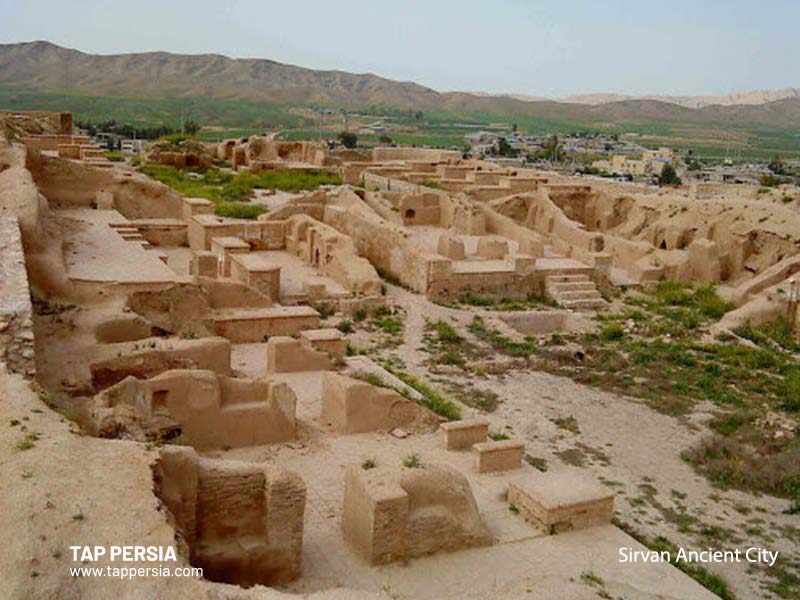
The historical city of Sirvan is one of the most prominent monuments of pre-Islamic times. Remains of castles, yards, paths and residential areas in this ancient city are signs of Sassanid architecture and determine its grandeur in the past.
The historic city of Sirvan is in a mountainous region with outstanding natural potential. The Seymareh River flows near this ancient city and is the main reason for the development of these areas. Visiting this city is very attractive not only for those who are interested in history but also for nature lovers.
Ilam Natural History Museum is one of the great museums and places of interest in Ilam, which has two floors. The museum exhibits fossils from different eras of the earth as well as taxidermy animals.
Today I want you to discover a different style of the art of creation, …